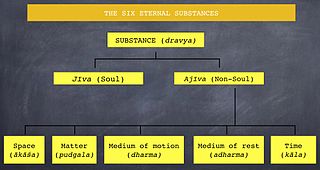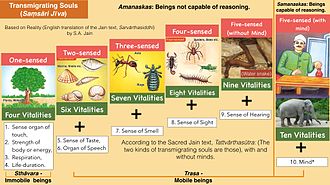Jainism also known as Jain Dharma, is an ancient Indian religion. Jainism traces its spiritual ideas and history through the succession of twenty-four Tirthankaras, with the first in the current time cycle being Rishabhadeva, whom the tradition holds to have lived millions of years ago; the twenty-third tirthankara Parshvanatha, whom historians date to 9th century BCE; and the twenty-fourth tirthankara, Mahavira around 600 BCE. Jainism is considered to be an eternal dharma with the tirthankaras guiding every time cycle of the cosmology. The three main pillars of Jainism are ahiṃsā (non-violence), anekāntavāda (non-absolutism), and aparigraha (asceticism).
Akasha or Akash means space or sky or æther in traditional Indian cosmology, depending on the religion. The term has also been adopted in Western occultism and spiritualism in the late 19th century. In many modern Indo-Aryan languages and Dravidian languages the corresponding word retains a generic meaning of "sky".
According to various Indian schools of philosophy, tattvas are the elements or aspects of reality that constitute human experience. In some traditions, they are conceived as an aspect of deity. Although the number of tattvas varies depending on the philosophical school, together they are thought to form the basis of all our experience. The Samkhya philosophy uses a system of 25 tattvas, while Shaivism recognises 36 tattvas. In Buddhism, the equivalent is the list of dhammas which constitute reality, as in Nama-rupa.

Ajiva (Sanskrit) is anything that has no soul or life, the polar opposite of "jīva" (soul). Because ajiva has no life, it does not accumulate karma and cannot die. Examples of ajiva include chairs, computers, paper, plastic, etc.
In Jainism, Pudgala is one of the six Dravyas, or aspects of reality that fabricate the world we live in. The six dravyas include the jiva and the fivefold divisions of ajiva (non-living) category: dharma (motion), adharma (rest), akasha (space), pudgala (matter) and kala (time). Pudgala, like other dravyas except kala is called astikaya in the sense that it occupies space.
Anekāntavāda is the Jain doctrine about metaphysical truths that emerged in ancient India. It states that the ultimate truth and reality is complex and has multiple aspects.

Tattvārthasūtra, meaning "On the Nature [artha] of Reality [tattva]" is an ancient Jain text written by Acharya Umaswami in Sanskrit, sometime between the 2nd- and 5th-century CE.

Vitality is the capacity to live, grow, or develop. More simply it is the property of having life. The perception of vitality is regarded as a basic psychological drive and, in philosophy, a component to the will to live. As such, people seek to maximize their vitality or their experience of vitality—that which corresponds to an enhanced physiological capacity and mental state.
Jain cosmology is the description of the shape and functioning of the Universe (loka) and its constituents according to Jainism. Jain cosmology considers the universe as an uncreated entity that has existed since infinity with neither beginning nor end. Jain texts describe the shape of the universe as similar to a man standing with legs apart and arms resting on his waist. This Universe, according to Jainism, is broad at the top, narrow at the middle and once again becomes broad at the bottom.

Karma is the basic principle within an overarching psycho-cosmology in Jainism. Human moral actions form the basis of the transmigration of the soul. The soul is constrained to a cycle of rebirth, trapped within the temporal world, until it finally achieves liberation. Liberation is achieved by following a path of purification.
According to Jain doctrine, the universe and its constituents—soul, matter, space, time, and principles of motion—have always existed. Jainism does not support belief in a creator deity. All the constituents and actions are governed by universal natural laws. It is not possible to create matter out of nothing and hence the sum total of matter in the universe remains the same. Jain texts claim that the universe consists of jiva and ajiva. The soul of each living being is unique and uncreated and has existed during beginningless time.

Ahimsā in Jainism is a fundamental principle forming the cornerstone of its ethics and doctrine. The term ahinsa means nonviolence, non-injury and absence of desire to harm any life forms. Vegetarianism and other nonviolent practices and rituals of Jains flow from the principle of ahimsa. There are five specific transgressions of Ahinsa principle in Jain scriptures - Binding of animals, beating, mutilating limbs, overloading, withholding food and drink. Any other interpretation is subject to individual choices and not authorized by scriptures.
Jain philosophy refers to the ancient Indian philosophical system found in Jainism. One of the main features of Jain philosophy is its dualistic metaphysics, which holds that there are two distinct categories of existence, the living, conscious or sentient being (jiva) and the non-living or material (ajiva).

Jain philosophy explains that seven tattva constitute reality. These are:—
- jīva- the soul which is characterized by consciousness
- ajīva- the non-soul
- āsrava (influx)- inflow of auspicious and evil karmic matter into the soul.
- bandha (bondage)- mutual intermingling of the soul and karmas.
- samvara (stoppage)- obstruction of the inflow of karmic matter into the soul.
- nirjara - separation or falling-off of part of karmic matter from the soul.
- mokṣha (liberation)- complete annihilation of all karmic matter.

According to Jain karma theory, there are eight main types of karma (Prikriti) which are categorized into the ‘harming’ and the ‘non-harming’; each divided into four types. The harming karmas directly affect the soul powers by impeding its perception, knowledge and energy, and also brings about delusion. These harming karmas are: darśanāvaraṇa, gnanavarniya, antarāya and mohanīya. The non-harming category is responsible for the reborn soul's physical and mental circumstances (nāma), longevity (āyuś), spiritual potential (gotra) and experience of pleasant and unpleasant sensations (vedanīya). In other therms these non-harming karmas are: nāma, āyu, gotra and vedanīya respectively. Different types of karmas thus affect the soul in different ways as per their nature. Each of these types has various sub-types. Tattvārthasūtra generally speaks of 148 sub-types of karmas in all. These are: 5 of jñānavaraṇa, 9 of darśanavaraṇa, 2 of vedanīya, 28 of mohanīya 4 of āyuṣka, 93 of nāma, 2 of gotra, and 5 of antarāya.
Jīva or Atman is a philosophical term used within Jainism to identify the soul. As per Jain cosmology, jīva or soul is the principle of sentience and is one of the tattvas or one of the fundamental substances forming part of the universe. The Jain metaphysics, states Jagmanderlal Jaini, divides the universe into two independent, everlasting, co-existing and uncreated categories called the jiva (soul) and the ajiva. This basic premise of Jainism makes it a dualistic philosophy. The jiva, according to Jainism, is an essential part of how the process of karma, rebirth and the process of liberation from rebirth works.

Dravya means substance or entity. According to the Jain philosophy, the universe is made up of six eternal substances: sentient beings or souls (jīva), non-sentient substance or matter (pudgala), principle of motion (dharma), the principle of rest (adharma), space (ākāśa) and time (kāla). The latter five are united as the ajiva. As per the Sanskrit etymology, dravya means substances or entity, but it may also mean real or fundamental categories.

Dravyasaṃgraha is a 10th-century Jain text in Jain Sauraseni Prakrit by Acharya Nemicandra belonging to the Digambara Jain tradition. It is a composition of 58 gathas (verses) giving an exposition of the six dravyas (substances) that characterize the Jain view of the world: sentient (jīva), non-sentient (pudgala), principle of motion (dharma), principle of rest (adharma), space (ākāśa) and time (kāla). It is one of the most important Jain works and has gained widespread popularity. Dravyasaṃgraha has played an important role in Jain education and is often memorized because of its comprehensiveness as well as brevity.

Umaswati, also spelled as Umasvati and known as Umaswami, was an Indian scholar, possibly between 2nd-century and 5th-century CE, known for his foundational writings on Jainism. He authored the Jain text Tattvartha Sutra. Umaswati's work was the first Sanskrit language text on Jain philosophy, and is the earliest extant comprehensive Jain philosophy text accepted as authoritative by all four Jain traditions. His text has the same importance in Jainism as Vedanta Sutras and Yogasutras have in Hinduism.










